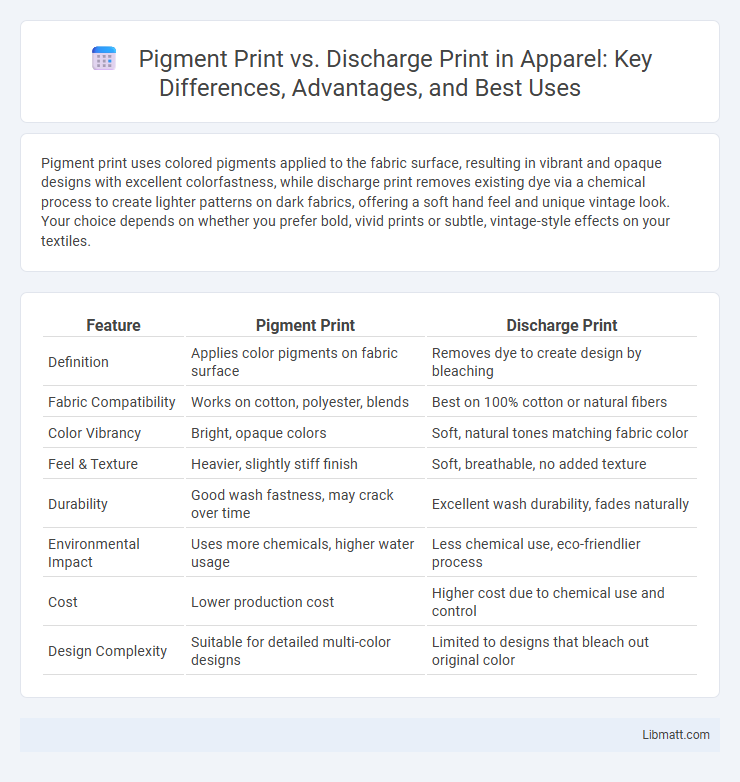Pigment print uses colored pigments applied to the fabric surface, resulting in vibrant and opaque designs with excellent colorfastness, while discharge print removes existing dye via a chemical process to create lighter patterns on dark fabrics, offering a soft hand feel and unique vintage look. Your choice depends on whether you prefer bold, vivid prints or subtle, vintage-style effects on your textiles.
Table of Comparison
| Feature | Pigment Print | Discharge Print |
|---|---|---|
| Definition | Applies color pigments on fabric surface | Removes dye to create design by bleaching |
| Fabric Compatibility | Works on cotton, polyester, blends | Best on 100% cotton or natural fibers |
| Color Vibrancy | Bright, opaque colors | Soft, natural tones matching fabric color |
| Feel & Texture | Heavier, slightly stiff finish | Soft, breathable, no added texture |
| Durability | Good wash fastness, may crack over time | Excellent wash durability, fades naturally |
| Environmental Impact | Uses more chemicals, higher water usage | Less chemical use, eco-friendlier process |
| Cost | Lower production cost | Higher cost due to chemical use and control |
| Design Complexity | Suitable for detailed multi-color designs | Limited to designs that bleach out original color |
Introduction to Fabric Printing Techniques
Pigment print uses colored pigments that sit on the fabric surface, offering vibrant colors and good colorfastness, ideal for cotton and blends. Discharge print removes dye from a dyed fabric with a bleaching agent, creating soft, breathable designs on dark-colored textiles. Understanding these fabric printing techniques helps you choose the best method for vibrant, durable patterns on various materials.
What is Pigment Print?
Pigment print is a textile printing method where colored pigments are applied directly to the fabric's surface, creating vibrant and durable designs. Unlike discharge printing, which removes or alters fabric dye, pigment printing forms a layer on top, offering sharp detail and excellent colorfastness on various materials. Your choice of pigment print ensures rich color intensity and resistance to fading after multiple washes.
What is Discharge Print?
Discharge print is a textile printing technique where a bleaching agent removes the original dye from a fabric, creating a lighter design on a darker background. Unlike pigment print, which adds color on top of the fabric, discharge printing chemically strips the color, resulting in a soft, breathable finish without added layers. Your choice of discharge print is ideal for vibrant, vintage-style designs on dark garments with a smooth texture.
Key Differences Between Pigment and Discharge Prints
Pigment prints apply color on the fabric surface using pigments and binders, resulting in vibrant designs with excellent colorfastness and durability. Discharge prints remove existing dye from the fabric using a chemical agent, creating soft, breathable patterns with a vintage look but potentially less color intensity. Your choice depends on the desired texture, color vibrancy, and fabric feel, as pigment prints offer bold colors on various textiles while discharge prints work best on dark, dyed cotton materials.
Color Vibrancy and Design Possibilities
Pigment prints offer excellent color vibrancy with sharp, bold hues that sit atop the fabric, making designs pop and allowing for intricate detailing. Discharge prints create a softer, more muted look by removing dye from the fabric and replacing it with new colors, providing a unique vintage feel but limited in design complexity. Your choice depends on whether you prioritize intense brightness or subtle, soft aesthetics for your print projects.
Suitability for Different Fabrics
Pigment print is highly versatile and suitable for a wide range of fabrics, including polyester, cotton, and blends, due to its ability to sit on the fabric surface without requiring chemical bonding. Discharge print excels on 100% cotton and other natural fibers, as it removes the dye to create vibrant, soft designs that retain breathability and comfort. Your choice depends on the fabric type and desired fabric hand, with pigment printing offering broader compatibility and discharge printing providing superior softness on natural textiles.
Durability and Wash Fastness
Pigment prints offer superior wash fastness due to their dye particles sitting on the fabric surface, resisting color fading through multiple washes. Discharge prints, while vibrant initially, may exhibit reduced durability as the chemical bleaching process can weaken fabric fibers over time, leading to color degradation. Choosing pigment prints ensures long-lasting color retention and enhanced fabric integrity during repeated laundering cycles.
Environmental Impact and Chemical Use
Pigment printing uses water-based pigments that sit on the fabric surface, often requiring less water and energy but relying on synthetic binders that may persist in the environment. Discharge printing involves chemically removing dye from the fabric using reducing agents like chlorine or thiourea dioxide, generating hazardous wastewater and posing greater environmental risks. The chemical-intensive nature of discharge printing typically leads to higher toxicity and more complex effluent treatment compared to pigment prints.
Cost Efficiency and Production Speed
Pigment printing offers cost efficiency with lower setup costs and faster production speeds due to its direct application process, making it ideal for short runs and customized orders. Discharge printing involves higher upfront expenses and longer production times because it requires chemical treatment to remove dye before applying new colors, but it delivers vibrant, soft prints on dark fabrics. Businesses prioritize pigment printing for quick turnaround and budget-friendly projects, while discharge printing is chosen for premium quality and color brilliance despite its slower and costlier process.
Choosing the Right Printing Method for Your Project
Pigment prints offer vibrant, opaque colors ideal for bold designs on dark fabrics, providing excellent durability and color fastness. Discharge prints remove the garment's dye, creating soft, breathable designs with a vintage look, best suited for light or medium-colored cotton materials. Selecting the right method depends on fabric type, desired print feel, color vibrancy, and wash durability specific to your project's needs.
pigment print vs discharge print Infographic

 libmatt.com
libmatt.com